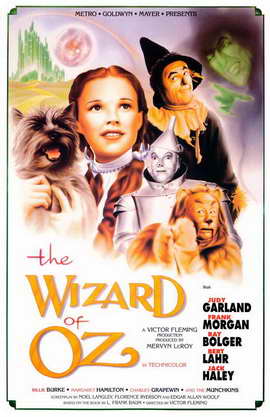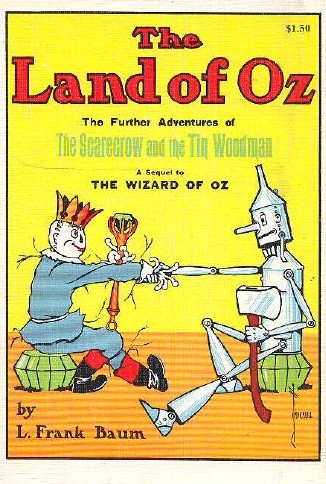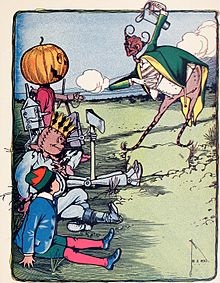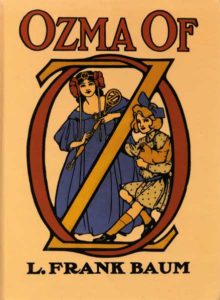
There’s a magical side to the element of sexuality that can be found only in fantasy. These lands include (drum roll, please) the mystical land of Imajica, Embassytown, and … Oz.
Oz?
Surely, I jest.
The fluid nature of sexuality is usually the provenance of science fiction – from Ursula’s K. LeGuin (The Left Hand of Darkness), through the 90’s with Melissa Scott (Shadow Man), and into today with Ann Leckie (Ancillary Justice) and John Scalzi (Lock In).
But one of the most influential American fantasies approached the subject quite a while ago – Frank L. Baum in his Oz series. The first book in the series, The Wonderful Wizard of Oz (published in 1900), was the only book not to feature the Princess Ozma, who started out life as the boy Tip, in the second book of the series – The Marvelous Land of Oz. Princess Ozma goes on to appear in every subsequent book (a total of 14 books). (All are available in the public domain in the US, and Oz is thus an “open” world, however, MGM owns the Ruby Slippers.)

I’m an Oz fanatic because of Princess Ozma. When I finished reading The Wonderful Wizard of Oz, which I did because of the movie, I wanted more. Specifically, I wanted more Dorothy. But that was not to be – Dorothy appears only in the first book, although (due to the popularity of the characters from the film version) the Scarecrow and the Tin Man do show up. Instead, I got the story of the boy Tip, who escapes from the witch Mombi and runs away with Jack Pumpkinhead. He faces an all female Army of Revolt, led by General Jinjur, who wants to overthrow the Scarecrow, and with the help of the Tin Man, the “Highly Magnified and Thoroughly Educated” Woggle-Bug, and various mice, overcomes all obstacles and restore Oz to balance.
During all this, before the final confrontation, Glinda swoops in and reveals that Tip is not a boy, but was transformed by the witch Mombi, and is in reality (term used extensively loosely when talking about Oz) the Princess Ozma.
I had not seen that one coming! The entire book, I identified with Tip, in the usual way I did when encountering male protagonists at a young age (one had to work back then to find the women – one still does, much less any other genders/orientations/sexual identities) – I just projected myself as a boy and moved on.

Jack Pumpkinhead, Tin Woodman, Scarecrow, and Tip meet the Woggle-Bug
But then, after I’d spent most of the book being the adventurous boy, Tip, I was now, suddenly and without much adjustment, the Princess Ozma.
It flipped my brain – this was a new encounter for me. But I learned to react by how the other characters reacted – we all bring our experiences of life to fiction, and our experiences in fiction, to life. Let’s look at how Tip’s friends received this transformation.
Glinda walked to the canopy and parted the silken hangings. Then she bent over the cushions, reached out her hand, and from the couch arose the form of a young girl, fresh and beautiful as a May morning. Her eyes sparkled as two diamonds, and her lips were tinted like a tourmaline. All adown her back floated tresses of ruddy gold, with a slender jeweled circlet confining them at the brow. Her robes of silken gauze floated around her like a cloud, and dainty satin slippers shod her feet.
At this exquisite vision Tip’s old comrades stared in wonder for the space of a full minute, and then every head bent low in honest admiration of the lovely Princess Ozma. The girl herself cast one look into Glinda’s bright face, which glowed with pleasure and satisfaction, and then turned upon the others. Speaking the words with sweet diffidence, she said:
“I hope none of you will care less for me than you did before. I’m just the same Tip, you know; only—only—”
“Only you’re different!” said the Pumpkinhead; and everyone thought it was the wisest speech he had ever made.
 That’s it. Tip’s friends accept the transformation into Princess Ozma, and I quite happily spent the rest of the series following her around the delightfully weird land of Oz.
That’s it. Tip’s friends accept the transformation into Princess Ozma, and I quite happily spent the rest of the series following her around the delightfully weird land of Oz.
The Land of Oz has a rich history of literary analysis with different interpretations – from monetary (gold standard versus silver) to Littlefield’s interpretation of Oz as political satire.
Frank was a noted Populist of South Dakota supporter, and the Populist platform included suffragette issues and rights, so it is no accident that the strongest characters of Oz are women – they form the backbone of Oz structure, are its antagonists and protagonists.
Oz is, and always shall be, much more subversive then it seems. We should all experience Tip’s world and transformation, we should all consider reacting as her friends do – with unconditional acceptance. So, follow the Yellow Brick road. Spend some time in Oz – your time there will never age you.

No Comments